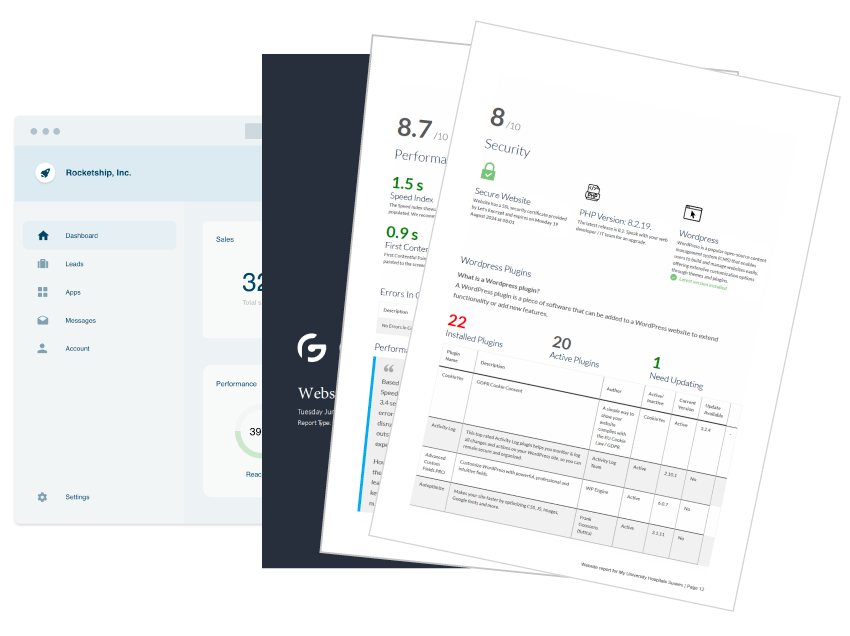10 secrets to keep your website fresh
Ever wondered how often you should refresh your website to keep it relevant and effective? Just like fashion trends, web design evolves rapidly, and your website might need more than just a few tweaks to stay ahead. Your website isn’t just a static online brochure—it’s a dynamic tool for engaging customers, driving sales, and growing your business. So, how often should you update or redesign to keep your website fresh and performing at its best?
Dive into our latest article to discover how to keep your website fresh and how often businesses should consider a redesign. Discover how Gold Pebble can help you extend the lifespan of your website, keep your digital presence in top shape and keep your website fresh!
The life expectancy of a Website: What’s normal?
A recent study by web experts, Search Engine Land, revealed that the average lifespan of top marketing websites is about 2 – 3 years. This shorter cycle makes sense for high-visibility brands that are constantly evolving. For smaller businesses, however, the timeline can vary significantly. Some may redesign every few years, while others might stretch their redesigns to a decade. The key is understanding when your site starts showing signs of age and taking proactive steps to address it.
Why your Website needs a refresh
Outdated Design Trends: Design trends evolve rapidly. What looked cutting-edge a few years ago may now seem outdated. A modern, visually appealing design not only improves user experience but also boosts your site’s credibility and engagement.
Changing Business Goals: As your business evolves, so should your website. Whether you’ve expanded your product line, shifted your target market, or updated your brand identity, your website should accurately reflect these changes. An outdated site can misrepresent your business and potentially turn away new customers.
Declining Performance: Have you noticed a drop in your site’s search engine rankings or user engagement? Over time, without regular updates and optimisation, performance can lag. A redesign with a fresh SEO strategy can revitalise your site’s visibility and drive more traffic.

10 factors of website longevity and how to address them
Keeping your website fresh and effective is crucial to staying competitive and meeting your audience’s needs. Understanding how long a website should last and what factors influence its longevity can help you make informed decisions about when and how to update your site.
The following 10 factors will determine your website lifespan, from industry trends and visitor expectations to technological advancements and security needs. We’ll not only explore each factor in detail but also provide actionable strategies to address them, ensuring your website remains a powerful tool for driving engagement, enhancing user experience, and achieving your business goals.
1. Industry Changes
| Why? | Industries such as tech and design evolve rapidly, with frequent updates in best practices and technological advancements. Staying relevant means adapting your website to reflect current trends and maintain industry credibility. |
| What to do | Regularly review industry trends and competitor websites. Consider quarterly or bi-annual site audits to ensure your design and functionality align with current standards. This helps you stay competitive and resonate with industry expectations. |
| Business Benefit | Keeping up with industry trends not only enhances your site’s credibility but also attracts potential customers who expect modern, up-to-date experiences. |
2. Visitor Expectations
| Why? | User expectations change with advancements in technology and design. An outdated website can frustrate users and lead to higher bounce rates. |
| What to do | Conduct user research and gather feedback to understand current expectations. Implement user-centric design improvements and ensure your site’s functionality meets modern standards. |
| Business Benefit | Meeting or exceeding visitor expectations improves user satisfaction, reduces bounce rates, and increases conversion rates. |
3. Technological Advancements
| Why? | New technologies can offer enhanced features, better performance, and improved security. Failing to integrate these can leave your site lagging behind. |
| What to do | Keep abreast of technological developments relevant to your website. Regularly update your site’s backend and integrate new technologies that can enhance performance and security. |
| Business Benefit | Leveraging new technologies boosts site performance, provides a competitive edge, and protects against security threats. |
4. Content Strategy Changes
| Why? | As your content strategy evolves, your website should accommodate these changes. This includes shifts in content formats, frequency, and publishing methods. |
| What to do | Regularly assess your content strategy and update your site’s structure and features to support new content types, such as blogs, videos, or interactive elements. |
| Business Benefit | Aligning your website with your content strategy enhances user engagement, supports your marketing efforts, and maximises content effectiveness. |
5. Mobile Responsiveness
| Why? | With increasing mobile internet usage, your website must be optimised for various devices. An outdated site may not perform well on mobile devices, affecting user experience. |
| What to do | Implement responsive design techniques to ensure your site looks and functions well on all devices. Regularly test and update your mobile site to accommodate new devices and screen sizes. |
| Business Benefit | A mobile-friendly site improves user experience for a growing number of mobile users, leading to higher engagement and conversions. |
6. Competitor Activity
| Why? | If competitors are frequently updating their websites, your site may seem outdated by comparison, which can impact your competitive position. |
| What to do | Monitor competitor websites and industry benchmarks. Regularly evaluate your site’s features and performance against competitors to identify areas for improvement. |
| Business Benefit | Staying ahead of competitors with a modern, well-maintained website helps attract and retain customers, and positions your business as a leader in the market. |
7. Design Trends
| Why? | Design trends evolve, and an outdated design can affect user perception and engagement. Keeping your site visually appealing is crucial. |
| What to do | Periodically review design trends and make updates to your site’s look and feel. Consider a design refresh every few years to incorporate modern aesthetics and usability improvements. |
| Business Benefit | A visually appealing site enhances brand perception, attracts visitors, and encourages longer site visits. |
8. Usability Issues
| Why? | A site that is difficult to navigate or use can deter visitors. Regular usability assessments help identify and resolve issues that affect user experience. |
| What to do | Conduct usability testing and gather user feedback to identify pain points. Make iterative improvements to navigation, layout, and interactive elements to enhance ease of use. |
| Business Benefit | Improved usability leads to higher user satisfaction, reduced bounce rates, and increased conversions. |
9. Security Needs
| Why? | Outdated websites are more susceptible to security breaches. Regular updates and security measures are essential to protect your site and data. |
| What to do | Implement regular security audits and updates. Utilize up-to-date security protocols and technologies to safeguard your site from potential threats. |
| Business Benefit | Enhanced security protects your business and customer data, reduces the risk of breaches, and maintains trust and credibility. |
10. Performance Metrics
| Why? | Performance issues, such as slow load times or high bounce rates, can negatively impact user experience and search rankings. |
| What to do | Monitor key performance metrics, such as load times and bounce rates, using analytics tools. Optimise site performance through updates, code improvements, and efficient content management. |
| Business Benefit | Improved site performance enhances user experience, boosts search engine rankings, and increases overall site effectiveness. |
How Gold Pebble can help
At Gold Pebble, we specialise in helping businesses like yours stay ahead of the curve. One way to get started is via our comprehensive website reports. These provide you with:
SEO Optimisation: Implement strategies to improve search engine rankings and drive more traffic.
Performance Analysis: Identify and address issues affecting your site’s speed and functionality.
User Experience Enhancement: Improve navigation and design to boost user engagement.
